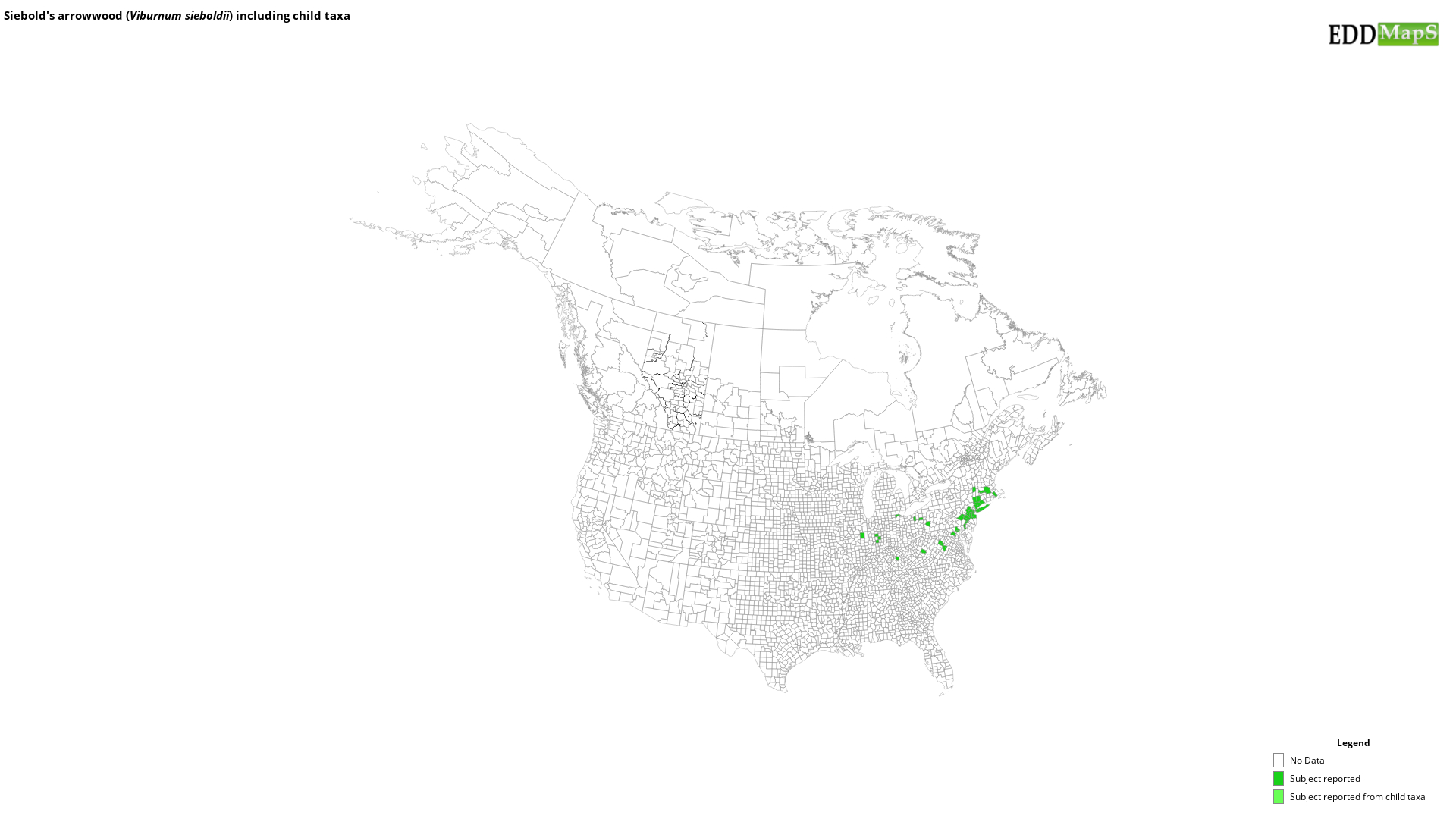Siebold's arrowwood
(Viburnum sieboldii)
This species is Introduced in the United States
ORIGIN: Japan
GROWTH TRAITS: Grows as a multi-stemmed shrub or small tree 15-20' (4.6-6.1 m) tall. The bark is gray-brown, rough, and furrowed with 79 prominent lenticels. Leaves are elliptical to oval-shaped and may have blunt tips. Leaves are 2-5" (5-12.5 cm) long, often leathery, and hairy on the veins and the petiole. They are deep green in summer and typically do not have fall color. Crushed leaves often emit a foul odor, though some describe this as the smell of green peppers. Flowers appear in flattened clusters at branch tips. Each flower is 0.25" (6 mm) in diameter. Fruits are spherical to oval-shaped, 0.3-0.5" (8-13 mm) long, and green initially but turn red and then black at maturity.
REPRODUCTION: Species spread by seed but can also re-sprout from the root system following damage. Seeds of many viburnums remain viable for up to 10 years.
HABITAT: Tolerates a wide range of soil conditions and can grow in full sun to partial shade. Grows best in mesic soil in full to partial sun and are typically found at forest edges, fields, and disturbed forests.
LOOK-ALIKES: Several additional viburnum species are native to or have been introduced to North America, and many are difficult to differentiate. They vary slightly in leaf shape, fruit color, buds, and flower and fruit structure.
CITATIONS:
Rawlins, K.A., R.L. Winston, C.T. Bargeron, D.J. Moorhead, and R. Carroll. 2018. New Invaders of the Northeast and Northcentral United States. USDA Forest Service, Forest Health Assessment and Applied Sciences Team, Morgantown, West Virginia. FHTET-2017-04. Retrieved from https://bugwoodcloud.org/resource/pdf/FHTET-2017-04_New%20Invaders_NE.pdf
GROWTH TRAITS: Grows as a multi-stemmed shrub or small tree 15-20' (4.6-6.1 m) tall. The bark is gray-brown, rough, and furrowed with 79 prominent lenticels. Leaves are elliptical to oval-shaped and may have blunt tips. Leaves are 2-5" (5-12.5 cm) long, often leathery, and hairy on the veins and the petiole. They are deep green in summer and typically do not have fall color. Crushed leaves often emit a foul odor, though some describe this as the smell of green peppers. Flowers appear in flattened clusters at branch tips. Each flower is 0.25" (6 mm) in diameter. Fruits are spherical to oval-shaped, 0.3-0.5" (8-13 mm) long, and green initially but turn red and then black at maturity.
REPRODUCTION: Species spread by seed but can also re-sprout from the root system following damage. Seeds of many viburnums remain viable for up to 10 years.
HABITAT: Tolerates a wide range of soil conditions and can grow in full sun to partial shade. Grows best in mesic soil in full to partial sun and are typically found at forest edges, fields, and disturbed forests.
LOOK-ALIKES: Several additional viburnum species are native to or have been introduced to North America, and many are difficult to differentiate. They vary slightly in leaf shape, fruit color, buds, and flower and fruit structure.
CITATIONS:
Rawlins, K.A., R.L. Winston, C.T. Bargeron, D.J. Moorhead, and R. Carroll. 2018. New Invaders of the Northeast and Northcentral United States. USDA Forest Service, Forest Health Assessment and Applied Sciences Team, Morgantown, West Virginia. FHTET-2017-04. Retrieved from https://bugwoodcloud.org/resource/pdf/FHTET-2017-04_New%20Invaders_NE.pdf
Selected Images
Maps
EDDMapS Distribution - This map is incomplete and is based only on current site and county level reports made by experts, herbaria, and literature. For more information, visit www.eddmaps.org
State Lists - This map identifies those states that have this species on their invasive species list or law.
Invasive Listing Sources
- Maine Invasive Plants
- Maryland Invasive Species Council - Invasive Species of Concern in Maryland
- National Park Service, Mid-Atlantic Exotic Plant Management Team Invasive Plant List
- New Invaders of the Northeast and Northcentral
- New Jersey Invasive Species Strike Team 2017 Invasive Species List
- Non-Native Invasive Plants of Arlington County, Virginia
- Pennsylvania Department of Conservation and Natural Resources Invasive Plants
- WeedUS - Database of Plants Invading Natural Areas in the United States
Taxonomic Rank
| Domain: Eukarya |
| Kingdom: Plantae |
| Phylum: Magnoliophyta |
| Class: Magnoliopsida |
| Superorder: Asteranae |
| Order: Dipsacales |
| Family: Adoxaceae |
| Genus: Viburnum |
| Viburnum sieboldii |
References
Common Name Reference: USDA, NRCS. 2010. The PLANTS Database. National Plant Data Center, Baton Rouge, LA, USA.
Scientific Name Reference: USDA, NRCS. 2010. The PLANTS Database. National Plant Data Center, Baton Rouge, LA, USA.


